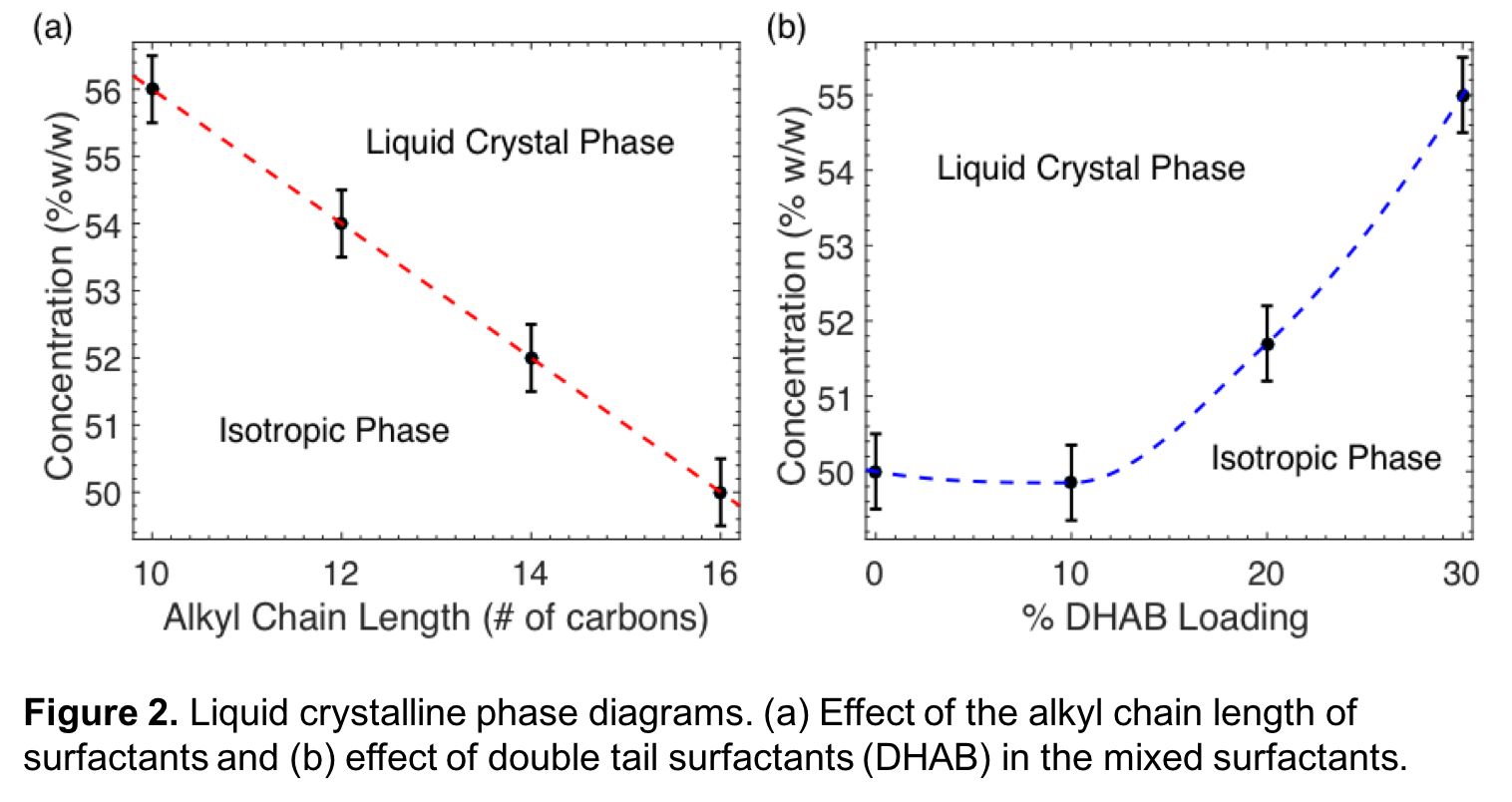Reports: UR753970-UR7: Surfactant-Induced Multiscale Assembly of Aqueous Conjugated Polymers
Shanju Zhang, PhD, California Polytechnic State University
Conjugated polymers possess one-dimensional (1D) p-orbital overlaps along the backbone and thus display intriguing anisotropic properties in optoelectronic characteristics including absorption, emission and charge transport. Macroscopic alignment of conjugated polymers via directed assembly plays a critical role in fully utilizing such unique anisotropic properties. We have invented a facile method of surfactant-directed assembly of conjugated polymers at different length scales. During the first year of this award, we reported the assembled structures and properties of diluted solutions of conjugated polymer-surfactant complexes.
During the second year of this award, we studied the liquid crystalline behavior of concentrated solutions of supramolecular complexes. We used polarized optical microscope to determine the phase boundaries and liquid crystalline textures. Under appropriate conditions, the conjugated polymer-surfactant complexes underwent a coil-rod transition. With increasing the concentration above a critical value, the system showed strong birefringence, indicative of a lyotropic liquid crystalline phase (Figure 1a). After mechanical shear flow, the liquid crystalline solution exhibited a banded texture that is perpendicular to the shear direction (Figure 1b).
To identify detailed liquid crystalline phases, small angle X-ray scattering (SAXS) was applied to the concentrated solutions of supramolecular complexes. The samples demonstrated multiple scattering peaks. The primary and higher order peaks occurred at a ratio of q-vectors of 1:3_ :2, which is characteristic of hexagonally packed microstructures. In this regard, the polymer chains adopted cylindrical domains in the hexagonal phases. We investigated temperature-dependent SAXS to determine the order-disorder transition temperature. The heating and cooling data displayed good consistency, indicative of a fully reversible phase transition. During heating, the scattering peak positions shifted slightly toward higher q values, showing the d-spacing of the cylindrical domains decreased. The order-disorder transition occurred around 110C that was marked by the disappearance of the hexagonal scattering peaks. We also used polarized optical microscope to determine the order-disorder transition which was consistent with the SAXS data.
We investigated the effect of the surfactant architecture on the liquid crystalline behaviors using polarized optical microscope, including the length of hydrocarbon chains and single/double tail ratio of mixed surfactants. The liquid crystalline phase diagrams were established (Figure 2). With increasing the length of hydrocarbon chains of surfactants, the critical concentration from isotropic to liquid crystalline phases reduced (Figure 2a), showing that the aspect ratio of rod conformation in solution increased. This result was consistent with the SAXS data. While the introduction of the double tail surfactant decreased the aspect ratio of rod conformation and therefore shifted the phase boundaries toward higher concentration (Figure 2b). This observation is also consistent with the absorption spectroscopic data of diluted solutions.
In summary, we studied the liquid crystalline behaviors of concentrated solutions of supramolecular complexes of conjugated polymers during the second year of this award. We plan to combine the research data of diluted solutions (first year) and that of concentrated solutions (second year) to address surfactant-directed assembly of conjugated polymer solutions for publication in a peer-reviewed journal. Future research work includes the microstructures and properties of solid think films (third year).
To date, two MS graduate student and three undergraduate students have been involved in research from the support of this award. One student represented Cal Poly to attend California State University (CSU) Research Competition. The research resulted in one Best Poster Award in Western Coatings Symposium and one Outstanding Undergraduate Research Award. There have been four oral talks and posters given by undergraduate and graduate students in the national and regional conference meetings.













